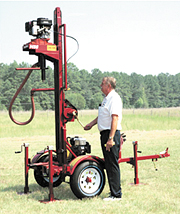
Most of the manufacturers of these mini-drills advertise their drills are capable of drilling to 200 feet. Realistically, however, they operate best at less than 100 feet. Some are built with larger engines (these are called commercial models), however, inexperienced operators should limit their drilling to less than 100 feet, at least until they gain some drilling knowledge and experience. I've drilled as deep as 300 feet with these 200-foot mini-drills, but this is for only very experienced operators. I've successfully drilled wells with these mini-drills in sands, clays, coral and rock, but most of these drills should be limited to sands and clays.
Some of these mini-drills have the pull-down capability or the option of adding weight to the drilling head. It's not recommended, but we've even tied bags of sand to and even stood on the drill head to add weight. Pull-down or weight is needed to drill rock using a roller cone (rock) bit. Sometimes this is a good option, however, using pull down or adding weight to the drill head presents new problems. It will add additional wear to the tophead drive and can add to the possibility of a crooked hole and/or a bent or broken drill stem and lost drill tools in the hole.
Another better and faster option to drilling rock with these mini-drills is to use an air compressor, drilling foam and a down hole hammer (DHH). This requires a completely different concept of using air to drill instead of mud.
A few of the manufacturers presently are experimenting with using the DHH method of drilling with the mini-drills. I believe that they will be adding this as a drilling option for their mini-drills in the near future.
Only a limited number of the manufacturers of the mini-drills have any drilling experience at all. Most are manufacturers and not drillers. Some have gained a limited drilling experience from their mini-drill customers calling in with drilling problems. A few continue to stumble through solutions for the purchasers.
Some of these manufacturers recommend the purchasers of their mini-drills call Porky when they have a drilling problem or question about drilling. I'm usually able to walk them through their problem.
There are a few manufacturers of the little larger trailer- or truck-mounted drills that are an even better option in some cases. These drills usually are advertised to drill to 600 feet under normal drilling conditions - however, there are very few normal drilling conditions! Ideally, these 600-foot drills are best suited for drilling less than 400-foot depths. They are bigger, faster and stronger. These drills are great for tight locations, geothermal loops and developing countries.
The wisest mini-drill and small drill manufacturers usually tell their prospective buyers to call Porky to recommend the proper equipment size to purchase. After asking a few drilling questions, I usually can recommend the best model and method of drilling.
In the near future, I believe we'll see a different trend in drilling machines! I believe that instead of thinking bigger is better, water well drilling will be leaning to compact as more practical.
I have 47-plus years of drilling experience with large drills; now that I'm a senior citizen, I prefer teaching people to drill with these mini- and small drills and writing for the National Driller.
ND

Report Abusive Comment